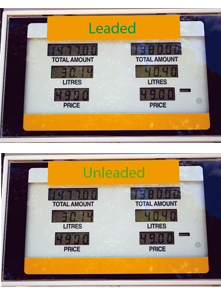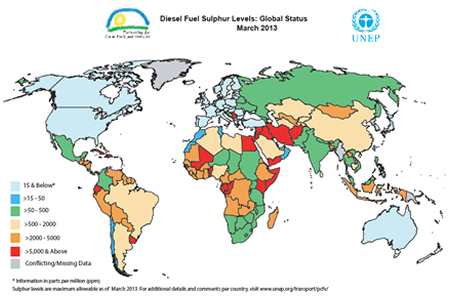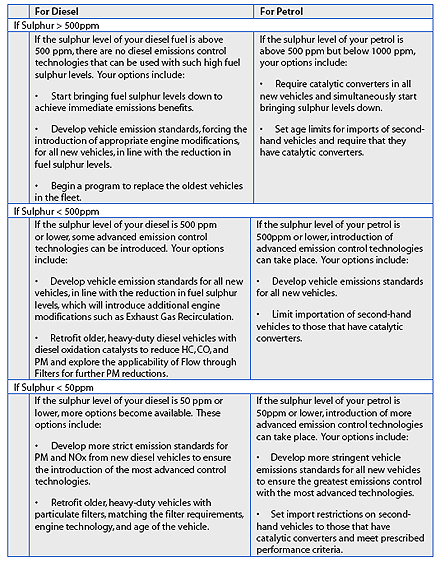
Clean Fuels
Unleaded petrolLow and ultra low sulphur fuels
Fuel infrastructure
Recognizing that fuels and vehicles work together as a system, the greatest benefits can be achieved by combining lower sulphur fuels with appropriate vehicle and emission control technologies. This approach has proven to be more effective than treating fuels, engines, or emission controls separately.
Car manufacturers are continuing to improve the design of engines to improve fuel efficiency and reduce emissions. For example, diesel engines with high pressure injection systems are more efficient and less polluting. However, these recent diesel engine technologies do not function well with high levels of sulphur fuel. For the latest information on auto fuel quality, including fuel sulphur levels, visit UNEP’s transport information hub.
Reducing emissions from motor vehicles is an important component of an overall strategy for reducing air pollution, especially in cities in developing and transitional countries where population and vehicle ownership are growing rapidly.

One essential component of reducing vehicle emissions is to eliminate lead from petrol; in addition to being a toxic pollutant in its own right, the presence of lead in petrol also inhibits the functioning of catalytic converters and other emission control technologies. Low sulphur fuel (both diesel and petrol, 500 ppm or less) is essential for lower emissions of PM and SOx, in addition to being a requirement for emission filters and advanced emission controls.
Unleaded petrol
Most modern petrol fuelled vehicles, including Hybrid Electric Vehicle (HEV), require unleaded petrol because of the irreversible damage lead causes to emission control technologies such as catalytic converters. One of the goals of the UNEP-based Partnership for Clean Fuels and Vehicles (PCFV, www.unep.org/transport/pcfv) is to phase out leaded petrol globally.
Both conventional vehicles and advanced technology vehicles (e.g. hybrid electric vehicles) with catalytic converters can be used with high sulphur petrol fuel as long as the fuel is unleaded. However, emission reduction technologies have a better efficiency with low and ultra-low sulphur fuels. The only technical requirement is unleaded fuel in order to ensure proper function of the catalytic converter.
This is very promising for the introduction of HEVs to developing countries, as unleaded petrol fuel is now available in most countries. Since fuel requirements set by car importers and car manufacturers can differ from region to region, one should check the requirements set by them to ensure the vehicle warrantee is maintained. If modern emission control technologies are used, e.g. NOx traps or Diesel Oxidation Catalyst, low sulphur fuels (500 ppm or less) will be required.
Low and ultra-low sulphur fuels and emission control technologies
Using diesel with lower levels of sulphur will reduce the emissions of sulfate, sulphur dioxide, and particulate matter (PM) substantially and will enable the introduction of advanced emission control technologies.
Sulphur occurs naturally in crude oil. The level of sulphur in diesel depends upon the source of the crude oil used and the extent to which the sulphur is removed during the refining process. While Western European, North American and a few Asian markets use ultra low sulphur fuels (50 ppm or less), sulphur levels as high as 5,000 to 10,000 ppm in diesel are still in use in developing and transitional countries. Diesel fuel with more than 500 ppm inhibits the use of any emission control technology available today, poisoning catalysts and particulate filters.Desulphurized diesel can be classified in the following categories, along with the emission control technologies enabled at each level:
- Low sulphur diesel (<500 ppm): Diesel with sulphur levels below 500 ppm enables the use of diesel oxidation catalysts (DOCs). However, the lower sulphur content, the more effective the catalyst becomes.
- Ultra Low Sulphur Diesel (ULSD, <50 ppm): Diesel with sulphur levels below 50 ppm enables the use of diesel particulate filters (DPFs) that reduce particulate matter substantially, in addition to providing effective control of CO and HC emissions.
- Near sulphur free diesel (15 ppm): Diesel fuel with even lower sulphur content below 15 ppm and even as low as 10 ppm enables effective control of NOx with, e.g. NOx traps and NOx adsorbers in new vehicles. For diesel particular filters (DPFs) the efficiency and effective life of the filter increases substantially with reductions from 50 to 15 ppm.
Sulphur greatly reduces the efficiency of more advanced catalysts by blocking active catalyst sites; this effect is not completely reversible. Although conversion efficiency will improve with the use of low sulphur fuel (500 ppm or less), it does not always return to its original effectiveness after desulphurization.
Optimal clean diesel vehicle function depends on the availability of near sulphur free diesel (<15 ppm) in order to attain specified emission levels and emission technology durability. As vehicle manufacturers might decline warranty demands when higher sulphur fuels are used, ensuring adequate fuel quality for correct vehicle function is important.
Fuel infrastructure
The infrastructure needed for cleaner and alternative fuels can be a major concern when it comes to new vehicle technologies. However, for diesels and hybrid electric vehicles, additional physical infrastructure is not needed as conventional fueling and distribution systems are used. In cases where a number of fuel grades are available on one market, adequate segregation in distribution and transport is essential for quality maintenance.









